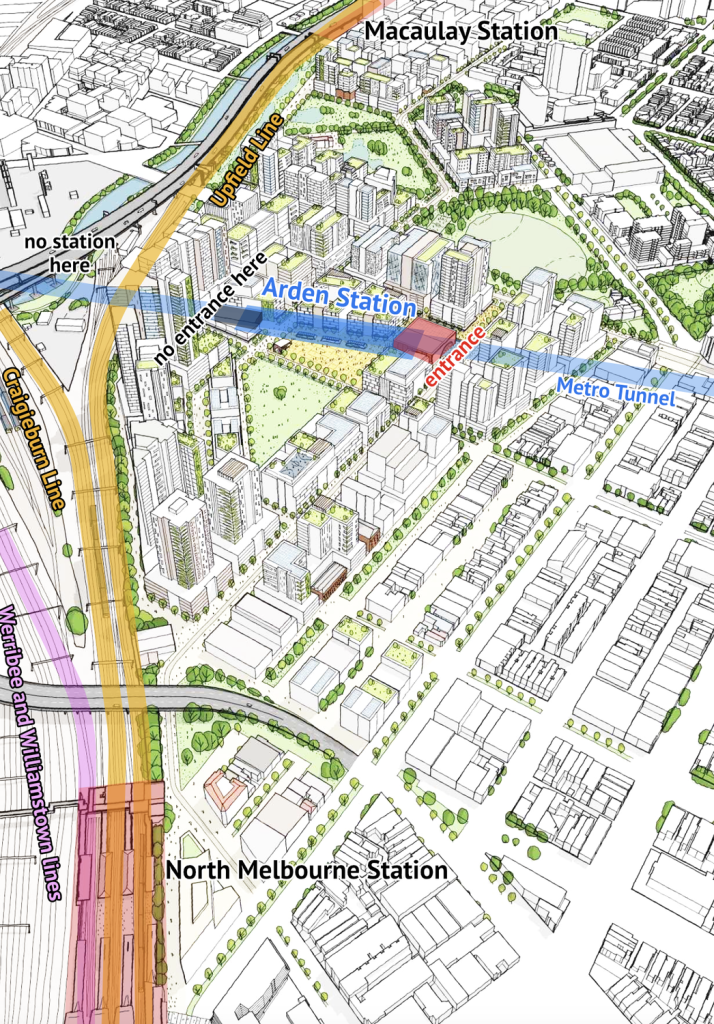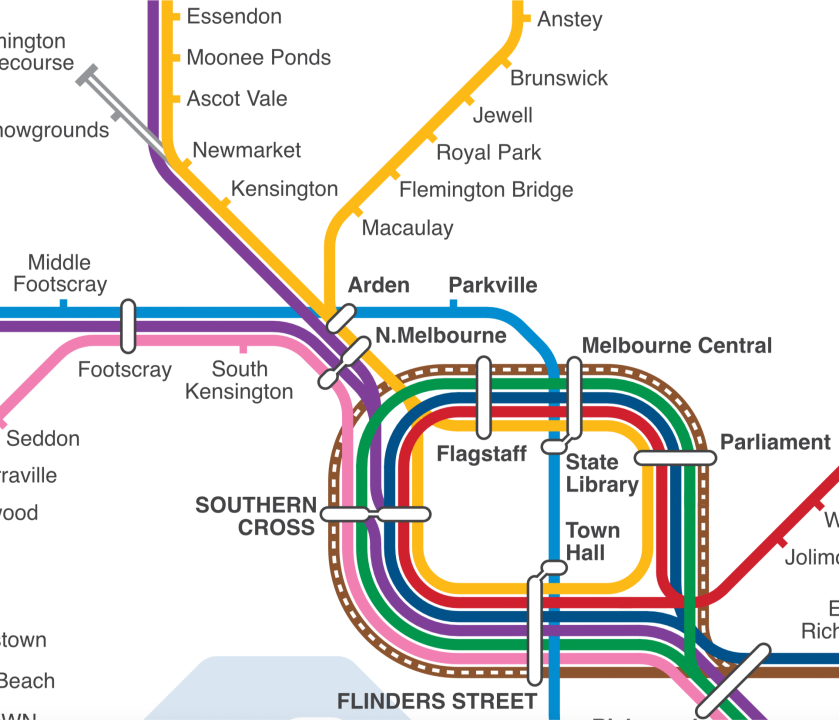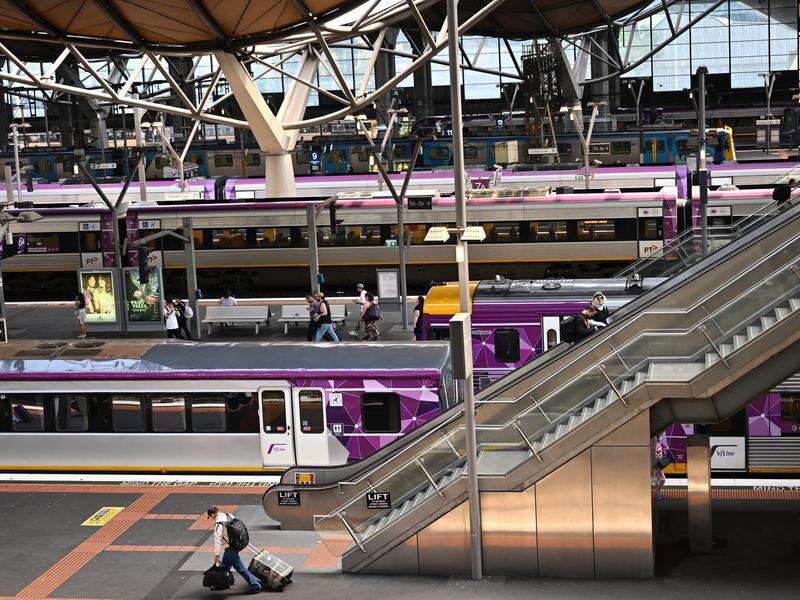A Public Transport Network is a set of lines and services designed to work together and allow people change between one another as they navigate the city.
The transition from a CBD-oriented commuter public transport network to one that aims at connecting as many people and places with each other as possible, at all times, inevitably requires dedicating attention to strengthening the peripheral connections.


Melbourne’s peripheral connections are currently extremely limited in service, and travelling between the suburbs—which do not sit on one and the same railway line—is, in most instances, notoriously and unnecessarily difficult.
Where exceptions occur, these are immediately met with high ridership, e.g. bus 246 in the inner city, or bus 902 in the outer. That is, people tend to use things that are useful to them, which means things should be designed to be useful, in the first place.

The Metro Tunnel is one of the primary projects aimed at delivering abundant access and stitch together Melbourne’s East and West, with broad range of positive impacts to regionwide accessibility.
The only through-running service in the entire city of Melbourne today—Frankston to Williamstown/Werribee—is consistently impacted by speed limits and delays around Flinders St and Southern Cross which have too many trains trying to get through them all at once.
The Metro Tunnel bypasses this chokepoint altogether and merges Pakenham, Cranbourne, and Sunbury lines into a fast and unified through-running service. It is expected that it will later also include the Melton line (when electrified) and Airport line (when built).

While the Metro Tunnel is going to dramatically improve the cross-city travel opportunities, in some instances, its design solutions lead to accessibility losses rather than gains, due to missing connections, trains passing through major destinations without stopping there, or both.
One of those missing opportunities is Arden station.
This article explores in detail what’s missing, what the impacts are, and what could be the ways to fix it.
Arden precinct and trains that don’t stop there… yet?
Arden is a large-scale mixed-use urban development project off the Western edge of Melbourne CBD. It envisages a broad range of different activities and is aimed at holistically creating a new place for everyone, one that is much more than just a mere sum of its components.

Its scale and complexity make it a unique destination in the city. Over two thirds of the masterplan are going to be shaped by buildings over 12 storeys in height, with some land plots identified for high-rises of up to 24-26 and even 40 storeys.
Such a dense and attractive place may only be possible with strong public transportation connections, and right in the middle of what will in a few years become a new part of Melbourne there is the new Metro Tunnel’s Arden station.


Alongside the Western edge of the precinct run the tracks of Upfield line, which are also followed by the Craigieburn line tracks in the South-Western part of the masterplan.
Both these lines serve Melbourne’s Northern suburbs and are responsible for approx.10% of boardings on the entire Metropolitan Trains network.
North Melbourne station, which, among others, serves both Craigieburn and Upfield lines, is located approximately 650 metres South of Arden precinct centre and Arden station. Upfield line’s Macaulay station is approximately 700 metres North of the same place. Both these lines pass by the heart of Arden precinct without stopping and cross the Metro Tunnel with no interchange to its Arden station.
The bird’s eye view artist impression from Draft Arden Structure Plan 2020 gives us an opportunity to have the most comprehensive overview of this layout.

This is a missing link that is problematic in two ways:
Firstly, Upfield and Craigieburn lines are missing a station in the middle of what would eventually be one of the densest and most populated places in Melbourne – whilst passing right by it.
Secondly, lack of connection between Upfield & Craigieburn lines and the Metro Tunnel both negatively affects the peripheral accessibility and diminishes the benefits of the Metro Tunnel itself.
As we’ve largely explored the former, let’s now concentrate on the latter.
Loops, Backtracking, And Getting From Here to There
I am Here and I need to go There. The shape of this desire is a straight line.
(This extremely beautiful way of explaining this concept, among many other things, is something I learned from the great public transport planning practitioner, Jarrett Walker.)

Most train lines on the Melbourne Metropolitan Trains’ network work as radials that come together in the CBD into what’s known as the City Loop. To understand the Arden problem better we must first dive into how the City Loop works.
Melbourne’s City Loop is unique: it is a set of four independent single-track loops around the CBD. Each track serves a group of lines, each represented by a color in the Melbourne Trains’ map, i.e. Sunbury, Upfield, and Craigieburn trains would all use the same platform whilst travelling through the Loop.
What is more important, however, is that ‘single-track’ means all trains need to travel in one direction only. And the City Loop is large enough—and time-consuming enough to travel around—for this to be a problem.
For example, a direct trip from North Melbourne to Flagstaff would require travelling only one station, whereas to get back from Flagstaff to North Melbourne you’d need to travel five stations around the loop. Running trains from North Melbourne around the City Loop in both directions at once is not possible: there is only one track that enters and exits the loop from the North.
People, however, do not travel in circles. They need to get where they are going in the most direct way possible. The realisation of this might have not come in in time as the City Loop was being conceived.
Given the constraints set by the infrastructure, the planners attempted to address the needs of the peak hour by changing the direction of travel on the City Loop throughout the day.
This was indeed convenient for the CBD-based nine-to-fivers, as they could now come back in the afternoon the same way they came in in the morning; however, in a large city that Melbourne is lots of people need to travel to lots of places other than the CBD at all times.
To all of them, this has introduced an incalculable level of complexity around planning their journeys and changing trains:


Now that we know how the City Loop works, let’s bring our attention back to Arden.
Very few things affect public transport usage negatively in a more profound way than the network and services designed to be taking people in the opposite direction of where they need to go.
As the Metro Tunnel aims to deliver the maximum accessibility outputs for the money invested, it has to be noted that the lack of interchange at Arden represents a noteworthy missed opportunity and, in some instances, is an accessibility issue.
For the passengers of Craigieburn and Upfield lines, travelling to Parkville via the Metro Tunnel, in its current form, is unfeasible.

To access the Metro Tunnel and get to Parkville station in the current network layout, Craigieburn and Upfield line passengers will need to proceed to the City Loop, change at one of the two stations in the CBD (depending on the time and day of travel) and backtrack to Parkville. Trams 19 and 59 will remain the more direct way of getting to Parkville for many people who would have otherwise taken the trains had the Arden interchange been in place.
Travelling between Melbourne’s Western and Northern suburbs will become less convenient than it is now.

The interchange between Sunbury line and both Craigieburn and Upfield lines at North Melbourne station is the essential connection when travelling between Western and Northern Suburbs.
As Sunbury line becomes incorporated in the Metro Tunnel, instead of changing trains at North Melbourne, people travelling between places like Sunshine and Brunswick will have to choose between:
- travelling to State Library or Town Hall to change trains there and backtrack,
- walking between Arden and North Melbourne (approximately 650 meters), or
- taking advantage of Werribee/Williamstown services and changing trains twice, at Footscray and North Melbourne, to still be able to jump on Craigieburn and Upfield lines there.
None of these options are convenient or feasible.

These problems can be fixed by introducing a new Arden station for Upfield and Craigieburn lines.
Let’s explore how this can be done.
Arden Interchange | Limited Investment Approach: At-Grade Station

To introduce a connection between the Metro Tunnel’s Arden station and a new potential station on the Upfield line, the former needs to get a proper second entrance, provisions for which have been mentioned in multiple documents, such as the Draft Arden Structure Plan.

This new entrance will need to have a direct underground corridor connection leading directly to Upfield line. Under the ideal circumstances, the walking distance between two platforms will be under 170 metres.

The platform of the Upfield’s line Arden station can occupy the place of the current V/Line sidings which are sometimes used for stabling and therefore will likely need to be relocated somewhere else rather than just be removed.

Connecting the Craigieburn line to Arden in a similar fashion is as well possible, however it presents a more complex engineering challenge.
It will have to be done in the constrained environment surrounded by the road flyover (Melbourne, you’ve built a highway on top of a beautiful river), an electric intake substation (to my limited understanding of urban power grids, these things are next to impossible to move someplace else), and a grade junction with Upfield line (which may pose restrictions on how close a station can be to such a junction and also cause a rail capacity problem).

If a station might be placed next to Arden with all the restrictions above in mind, this is the only location where this might be done reasonably.
The corridor connection to Metro Tunnel from Craigieburn line platform will be approximately 200 meters in length, which is more than would normally be advisable, however, again, is the best achievable option without building a completely new underground station directly next to the current Arden station or underneath it.
Some Craigieburn line trains, however, take an alternative route and use the flyover over Footscray-bound tracks and the pair of tracks South of Metro Trains’ stabling yard, which means that if we were to connect them to Arden, another platform might be required.

The walking distance from that platform to the Metro Tunnel’s Arden station would be approaching 300 meters. Such a distance is not perfect neither for changing trains nor for accessing places around the station, and, where possible, it should be minimised. To mitigate, it might be possible to consider moving this pair of tracks to the Northern side of the Metro Trains’ stabling facility, like so:

The design resulting from this approach has significant shortcomings.
Firstly, the walking distances involved are not universally user-friendly. If we consider a reasonable distance of 700 metres, representing roughly 10 minutes at an average walking pace, nearly a third of that distance remains consumed by traversing the access corridor between Arden station and most of the precinct. Moreover, to the other side of these stations, no urban development can be expected within foreseeable future, which means the real walking access to these stations would be limited.
Secondly, the at-grade junction of Upfield and Craigieburn lines would remain in place and still be a capacity and reliability problem as the frequency of services grows. With the suggested positions of the new platforms, it would be extremely hard, if not impossible, to address it later by building a split-level junction instead.
Finally, the Arden St level crossing would also have to remain in place, which would also be extremely hard to address later, as the only reasonable option to remove it would be to tunnel under the railway and Moonee Ponds Creek.
A more strategic approach, one that considers transportation holistically and places the creation of a connected, integrated public transport network as a top priority, needs to be explored.
Arden Interchange | Strategic Investment Approach: Going Underground
Although it always comes at a significant cost, going underground provides a wide range of opportunities that are otherwise inachievable when the existing lines and tracks are involved.
Placing an underground station for Upfield and Craigieburn right next to the Metro Tunnel’s Arden station would allow to prioritise and get the benefits of both the convenience of interchange and the directness of station precinct area access. Furthermore, it also allows to address the needs of removing both the at-grade junction of these two railway lines and the level crossings in the surrounding area.
As Craigieburn and Upfield line diverge South-West of Arden precinct, the introduction of an underground station as shown above moves that point further North and creates a set of geometrical challenges (such as reaching Kensington) that restrict the position of the new station largely to the Western edge of the development.

The resulting interchange will have three entrances, as the existing entrance at Laurens St will be complemented by Northern Entrance at Arden St and Western Entrance next to Fogarty St, the latter being shared by the three lines.
It will also be possible to accommodate a Victoria Line station located alongside Queensberry St axis. Its Western edge would use the Western Entrance, whereas its Eastern edge would produce an additional entrance from Laurens St.
Level Crossings Removal will likely require Kensington and Macaulay stations be moved underground
All three level crossings in the vicinity of Arden (one at Arden St for Upfield line and two at Macaulay Rd, respectively, for Upfield and Craigieburn lines) are not compatible with frequent train services and have been overdue for removal.
Going overground between North Melbourne and Flemington Bridge is challenging, if not impossible, due to location of the Citylink road, and going underground seems to be the option to pursue.
This means both Macaulay and Kensington stations will have to be moved underground, which consequently opens up an opportunity to reconsider the location of Macaulay station to improve the wider area coverage and generate more potential for further re-development.
(It needs to be mentioned that the beautiful brick pavilions of Kensington station must be preserved and will make a nice historical entrance to a brand new station.)

A four-track, two-platform arrangement would eliminate the grade junction of Craigieburn and Upfield lines and the interdependence of outbound and inbound trains, thereby increasing the line capacity and service reliability.
This layout also supports the potential delivery of the Inner Circle line which would become particularly relevant when the Metro Tunnel 2 gets built (as planned) and Upfield line is streamlined through Parkville (as not yet planned – but should be). (Sounds interesting? We’ll explore this in another article!)
Arden Interchange: What Can Happen If We Want It To

Building a connected public transport network should be approached strategically. This may come at a cost.
In public transportation, infrastructure defines what the service can do, and it is the service that is the most important part. Sending the users to backtrack from where they don’t need to go in the first place is unfeasible and will not allow building an integrated and useful public transport system. The costs and the design of infrastructure both need to be approached with the clear view of the what the service needs to do, and what it will do.
Arden interchange would address the shortcomings of the current development of both the Metro Tunnel and the Arden precinct. It would improve the public transport network connectivity and improve the accessibility of what is going to be one of the primary destinations in inner Melbourne, Arden precinct.
The best time to build Arden interchange is now.
The large scale and utmost complexity of Arden precinct which comprises a wide range of functions makes it a unique activity centre and destination that needs as much public transport accessibility as it can get.
The rail network in Melbourne needs to become more connected, rather than otherwise, and needs to enhance and support cross-city and peripheral connections, which should be recognised throughout all its infrastructure projects.
The Metro Tunnel is a critical investment and the key public transport project in Victoria which needs to deliver as much for the dollar spent as it possibly can, and, as identified in this article, its potential—if not compromised—is not being realised in full.
Craigieburn and Upfield lines run right next to the site and take care of approximately 10% of boardings on the entire Metropolitan Trains network. (If it weren’t for the very limited service levels on either of them, they would have already seen even more patronage). Omitting a station at Arden, which is soon to be one of the key destinations in Victoria, seems shortsighted. Lack of an interchange at Arden makes the Metro Tunnel considerably less useful to Craigieburn and Upfield line passengers.

As I am writing this, Arden precinct is awaiting applications for its development. The site is largely empty and ready for the construction workers to come in. Building new stations at any site is easier while it’s empty than when it’s built up.
If we think that creating Arden interchange is or will at a certain point be worth it, the best time to act is now.
Credit: Ilya Petoushkoff




I found this great article on Linkedin and it deserves to be more widely read therefore I reposted here with credit.